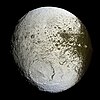|
تضامنًا مع حق الشعب الفلسطيني |
ملف:Iapetus as seen by the Cassini probe - 20071008 (cropped).jpg

الملف الأصلي (3٬547 × 3٬547 بكسل حجم الملف: 1٫47 ميجابايت، نوع MIME: image/jpeg)
| هذا ملف من ويكيميديا كومنز. معلومات من صفحة وصفه مبينة في الأسفل. كومنز مستودع ملفات ميديا ذو رخصة حرة. |
ملخص
| الوصفIapetus as seen by the Cassini probe - 20071008 (cropped).jpg |
English: Iapetus as seen by the Cassini probe. Original NASA caption: Cassini captures the first high-resolution glimpse of the bright trailing hemisphere of Saturn's moon Iapetus. Français : Japet vu par la sonde Cassini.
Traduction de la légende originale fournie par la NASA : Cassini obtient la première vue à haute résolution du brillant hémisphère arrière de Japet, une lune de Saturne. 中文:卡西尼探测器看到的土卫八. NASA最初的标题: 卡西尼捕捉到的第一幅高分辨率土卫八明亮的拖尾半球的图像. 这个伪色拼图显示了土卫八的整个半球 (跨越 1,468 km), 该半球可以在[卡西尼号于2007-09遇到该双色卫星时的伸出去的腿]上看到. 拖尾半球的中心经度是拼图中心向左 24 度. 该图还显示了暗的领头半球和亮的拖尾半球之间的复杂的过渡区域. 这个区域可沿图像右部看到, 并且在卡西尼接近最近路线时获得的很多图像中都能看到. 这里第一次在细节上显露了拖尾半球标志性的地质学结构. 这个区域看上去极为多坑, 尤其在北南两个极区. 接近拼图顶部, 许多撞击面貌可以在NASA的航行者2号飞船1981获得的图像中看到, 包括撞击坑Ogier和撞击坑Charlemagne. 这个视图中最突出的地貌是, 拼图的下半部, 一个 450 km 宽的撞击盆地, 在土卫八上至少有九个这样的大盆地. 实际上, 该盆地覆盖了一个更早的盆地, 即新盆地的东南方的那个尺寸相近的盆地.<br> 在很多地方, 暗的物质看上去覆盖了赤道 斜坡 和 坑底. 这些暗的物质推测成分是氮轴有机化合物即氰化物 水合矿物 和 其他含碳矿物. 跨越拖尾半球的明亮物质的分布和颜色变化, 将是至关重要的线索, 让我们去理解 土卫八的罕见的亮暗双重人格的起源. :) 视图由卡西尼太空船窄角度相机于 2007-09-10 获得, 相机距离土卫八大约 73,000 km . 此有色视图扩展了人眼视觉电磁波谱可见的波长. 暗材料的强烈的红褐色调远远不是真色图具有的. 增强色的采用使得暗材料的红属性比单纯人眼所见更显著. 该拼图来自跨越土卫八的表面的 60 个图像 覆盖了 15 个脚印 (基本测绘区域). 该视图是一个正射投影, 中心位于南纬10.8度, 西经246.5度, 分辨率为 426 米/像素. 一个正投影视图很像遥远的观察者通过望远镜所看到的情景. 每个脚印上, 全分辨率清晰过滤图由半分辨率图像组合而成, 这些半分辨率图像以红外 绿 和紫外光谱过滤器拍摄, 这些过滤器的中心波长分别是 752 nm, 568 nm 和 338 nm. 卡西尼-惠更斯任务是 NASA 欧洲空间局 和 意大利空间局的协作工程. JPL喷气推进实验室, 是加利福尼亚技术学院的一部分. 喷气推进实验室为华盛顿特区的NASA科学任务理事会管理着该工程. 卡西尼轨道器及其两个相机在喷气推进实验室设计开发和组装. 图像处理中心建于空间科学研究所(位于 Boulder, Colo). (译者注: California Institute of Technology in Pasadena, 或者翻译成加州工学院, 但不要翻译成什么 '理工大学' 那样太没谱了. 名词 '技术学院' 不同于中国大陆的技工职业教育院校专用的 '技术学院'. 技术一词应该是不分大小的真正的技术 而非中国大陆普遍认为并在传统上轻视的 '小小的技术'.) |
| التاريخ | |
| المصدر | PIA08384: The Other Side of Iapetus |
| المؤلف | NASA/JPL/Space Science Institute |
| الترخيص (إعادة استخدام هذا الملف) |
PD |
فُهرِست هذه الصُّورة أَو هذا التَّسجيل المرئي لدى Jet Propulsion Laboratory التَّابعة لوكالة الفضاء الأَمريكيَّة (ناسا) تحت المُعرِّف PIA08384. لا يُشير هذه الوَسم إلى حالة حقوق التَّأليف والنَّشر الخاصَّة بالعمل المُرفَق؛ لا يزال وَسم حقوق التَّأليف والنَّشر مَطلُوباً، راجع كومنز:ترخيص لمزيدٍ من المعلومات. لغات أخرى:
العربية ∙ беларуская (тарашкевіца) ∙ български ∙ català ∙ čeština ∙ dansk ∙ Deutsch ∙ English ∙ español ∙ فارسی ∙ français ∙ galego ∙ magyar ∙ հայերեն ∙ Bahasa Indonesia ∙ italiano ∙ 日本語 ∙ македонски ∙ മലയാളം ∙ Nederlands ∙ polski ∙ português ∙ русский ∙ sicilianu ∙ slovenščina ∙ Türkçe ∙ українська ∙ 简体中文 ∙ 繁體中文 ∙ +/− |
ترخيص
| Public domainPublic domainfalsefalse |
| يقع هذا العمل في النِّطاق العامّ في الولايات المُتحدة الأمريكيَّة لأَنَّه عملٌ خالِصٌ من إِنتاج وكالة الفضاء الأمريكيَّة. تنصُ حقوق التَّأليف والنَّشر الخاصَّة بوكالة الفضاء الأمريكيَّة على أنَّ "أعمال الوكالة غير مَحميَّة بحقوق التَّأليف والنَّشر ما لم يُذكر خلافُ ذلك". لمزيدٍ من المعلومات انظر القالِب {{PD-USGov}} وصفحة حقوق التَّأليف والنَّشر الخاصَّة بالوكالة وصفحة سياسة الصُّور الخاصَّة بمُختبر الدَّفع النَّفَّاث. |  | |
 |
تنبيهات:
|
اُستخرِجَ هذا الملفُّ مِن مَلفٍّ آخرَ هو : Iapetus as seen by the Cassini probe - 20071008.jpg |
الشروحات
العناصر المصورة في هذا الملف
يُصوِّر
٨ أكتوبر 2007
تاريخ الملف
اضغط على زمن/تاريخ لرؤية الملف كما بدا في هذا الزمن.
| زمن/تاريخ | صورة مصغرة | الأبعاد | مستخدم | تعليق | |
|---|---|---|---|---|---|
| حالي | 14:32، 27 نوفمبر 2015 |  | 3٬547 × 3٬547 (1٫47 ميجابايت) | commonswiki>PlanetUser | File:Iapetus as seen by the Cassini probe - 20071008.jpg cropped 13 % horizontally and 13 % vertically using CropTool with precise mode. |
استخدام الملف
ال1 ملف التالي مكررات لهذا الملف (المزيد من التفاصيل):
- ملف:Iapetus as seen by the Cassini probe - 20071008 (cropped).jpg من ويكيميديا كومنز
الصفحتان التاليتان تستخدمان هذا الملف:
